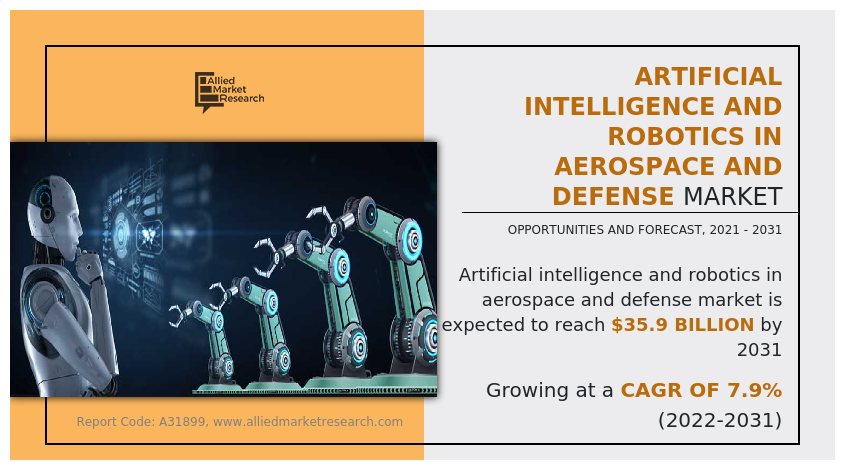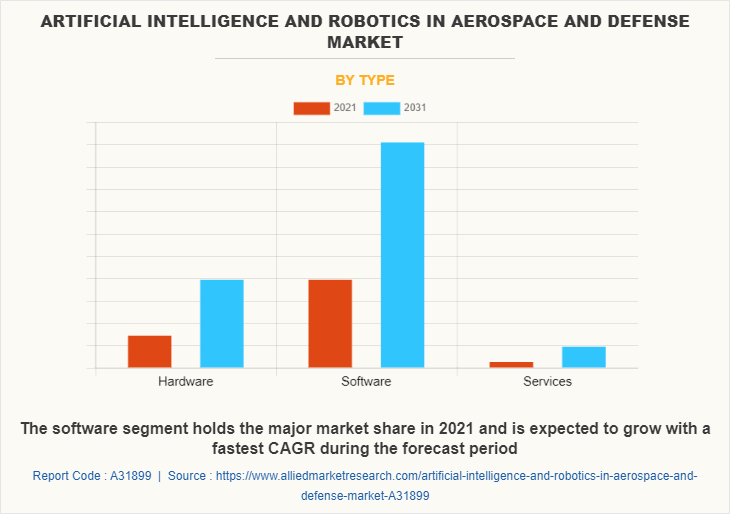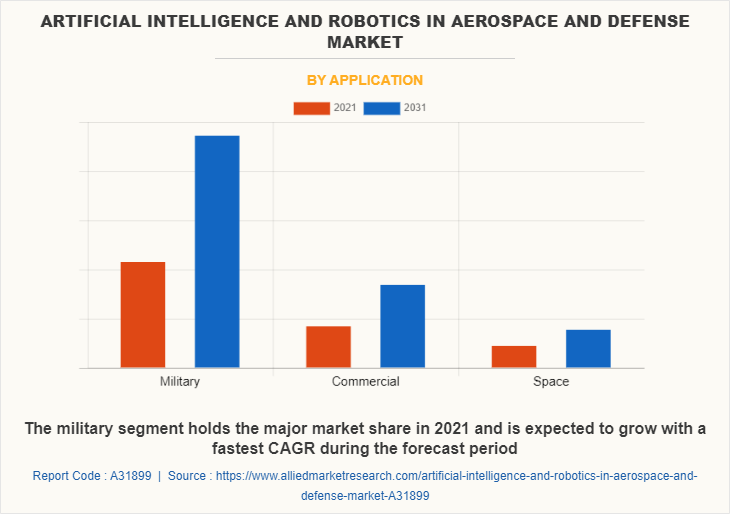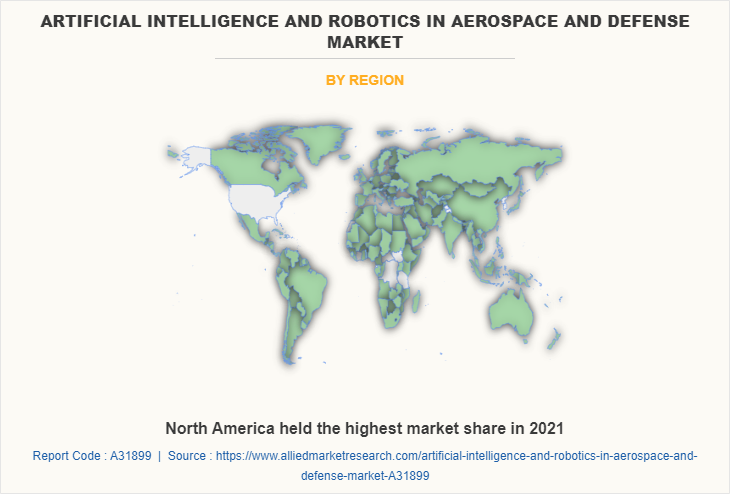AI and Robotics in Aerospace and Defense Market Overview
The global artificial intelligence and robotics in aerospace and defense market size was valued at USD 17.2 billion in 2021 and is projected to reach USD 35.9 billion by 2031, growing at a CAGR of 7.9% from 2022 to 2031.
The simulation of human intelligence processes by machines, particularly computer systems, is known as artificial intelligence. Expert systems, natural language processing, speech recognition, and machine vision are examples of AI applications. The increasing success rate of missions using such solutions, the adoption of artificial intelligence and robotics has increased in many fields. With the advent of Industry 4.0, advancements in robotics and artificial intelligence are assisting the AI and robotics in aerospace and defense market by bringing innovative technologies into robots used in various aerospace applications. AI and robotics are being developed in commercial aviation to automate airport operations and perform aircraft monitoring functions in order to better plan operations. It is also being implemented in the MRO sector to improve the efficiency of maintenance operations.

Robotics and artificial intelligence are two related but entirely different fields. Robotics involves the creation of robots to perform tasks without further intervention, while AI is how systems emulate the human mind to make decisions and learn. The use of artificial intelligence and robotics in the aerospace and defense sector facilitates in-depth data tracking with an ability to track, manage, and schedule maintenance of various military and defense equipment parts for maintenance and repairs. This helps in reducing the downtime of machines to boost productivity. Additionally, aerospace companies are using AI to boost the fuel efficiency of flight design based on weather, pilots, aircraft, and more.
Though AI technology and autonomous operations improve military decision-making and increase the speed and scale of military action, these technologies can also be unpredictable or vulnerable to novel forms of manipulation. As a result, there is skepticism about the dependability of AI-based systems and robots in future combat operations. In addition, several ethical concerns have been raised regarding the use of robots in complex warfare scenarios. Concerns about the use of killer robots that can fire weapons autonomously without a human in the loop have prompted scientists and organizations to urge the United Nations and world governments to consider a ban on killer robots. These concerns, as well as the resulting pressures on governments, are expected to stifle artificial intelligence and robotics in aerospace and defense market growth during the forecast period.
The industry players are investing a lot of effort on the research and development of smart and unique strategies to sustain their growth in the AI and robotics in aerospace and defense market. These strategies include product launches, mergers & acquisitions, collaborations, partnerships, and refurbishing of existing technology. In October 2021, IBM and Raytheon Technologies have entered into a collaboration agreement to develop advanced artificial intelligence, cryptographic, and quantum solutions for the aerospace, defense, and intelligence industries. For aerospace and government customers, the systems integrated with AI and quantum technologies are expected to have more secure communication networks and improved decision-making processes.
Key Market Players
AI and robotics in aerospace and defense key players such as Airbus SE, IBM Corporation, Boeing Company, GE Aviation, Thales Group, Lockheed Martin Corporation, Intel Corporation, Raytheon Technologies Corporation, General Dynamics Corporation, and Microsoft Corporation.
Segment Overview
The global artificial intelligence and robotics in aerospace and defense market is segmented on the basis of type, application, and region. By type, the market is sub-segmented into hardware, software, and services. As per application, the market is classified into military, commercial, and space. Region wise, the market is analyzed across North America, Europe, Asia-Pacific, and LAMEA. The artificial intelligence and robotics in aerospace and defense market is segmented into Type and Application.

By type, the software sub-segment dominated the market in 2021. This category includes a variety of software and algorithms developed by businesses or made available through open-source platforms. One of the major determining factors in the acceptance rate of AI-enabled technologies is software. Strategic agility and readiness are becoming more complex, necessitating improved operating systems. Data is a critical enabler for information-driven operations in novel domains such as cyber and space. Major corporations such as IBM, Microsoft, and Google enable anyone to gain hands-on experience in AI computation and provide unique datasets to the company, allowing it to understand future AI and robotics in aerospace and defense market opportunities.

By application, the Military sub-segment dominated the global artificial intelligence and robotics in aerospace and defense market share in 2021. The military segment's plethora of AI applications, such as big data analytics for better decision-making, automated logistics through the integration of unmanned ground vehicles (UGV) and unmanned aerial vehicles (UAV), bioinspired robots (swarm AI and deep neural networks), underwater mines location through neural networks, and object location, are expected to drive market growth during the forecast period.

By region, North America dominated the global AI and robotics in aerospace and defense market in 2021 and is projected to remain the fastest-growing sub-segment during the forecast period. The region's aerospace industry is primarily driven by the region's strong aviation base in the United States. The presence of major aerospace and defense incumbents in the country also aids in the development and integration of advanced robotics and artificial intelligence systems in the fields of manufacturing, maintenance, and other commercial and defense-oriented applications. Boeing and Sparkcongnition's joint venture, SKyGrid, announced plans to deploy an AI-powered cybersecurity system on drones in January 2021. The company claims that its DeepArmor solution, a patented ML cybersecurity technology, can significantly reduce the potent threat of cybersecurity exploits. The DeepArmor programme employs advanced AI models rather than a rules-based heuristics approach to protect against threats. The solution is intended for both industrial and military UAVs. Such developments paint a clear picture of North America's aerospace and military sectors' adoption of disruptive technologies such as AI and robotics during the projection period.
Key Benefits For Stakeholders
This report provides a quantitative analysis of the market segments, current trends, estimations, and dynamics of the artificial intelligence and robotics in aerospace and defense market analysis from 2021 to 2031 to identify the prevailing artificial intelligence and robotics in aerospace and defense market forecast.
The AI and robotics in aerospace and defensemarket research is offered along with information related to key drivers, restraints, and opportunities.
Porter's five forces analysis highlights the potency of buyers and suppliers to enable stakeholders make profit-oriented business decisions and strengthen their supplier-buyer network.
In-depth analysis of the artificial intelligence and robotics in aerospace and defense market segmentation assists to determine the prevailing AI and robotics in aerospace & defense Industry opportunities.
Major countries in each region are mapped according to their revenue contribution to the global artificial intelligence and robotics in aerospace and defense industry growth.
Market player positioning facilitates benchmarking and provides a clear understanding of the present position of the market players.
The report includes the analysis of the regional as well as global artificial intelligence and robotics in aerospace and defense market trends, key players, market segments, application areas, and market growth strategies.
Artificial Intelligence And Robotics In Aerospace And Defense Market Report Highlights
| Aspects | Details |
| Market Size By 2031 | USD 35.9 billion |
| Growth Rate | CAGR of 7.9% |
| Forecast period | 2021 - 2031 |
| Report Pages | 280 |
| By Type |
|
| By Application |
|
| By Region |
|
| Key Market Players | Lockheed Martin Corporation, Raytheon Technologies Corporation, ge aviation, Boeing Company, Thales Group, IBM Corporation, General Dynamics Corporation, Intel Corporation, Microsoft Corporation, Airbus SE |
Analyst Review
The growing use of AI-based technologies in the aerospace and defense (A&D) sector, as well as increased investments to develop and integrate AI and machine learning (ML) into end-user sectors, are expected to drive the market in focus during the forecast period. However, the associated technical and operational challenges that are frequently observed during the early stages of development and adoption of a nascent technology are impeding AI-based technology adoption. The Intelligence, Surveillance & Reconnaissance (ISR) systems make use of AI-based technologies, targeting technology, and autonomous drones. It is anticipated that the performance of the current platforms will improve as AI is included into the architecture of traditional combat networks. As the aerospace and defense (A&D) industry is anticipated to experience increased utilization of the next generation technologies, consequently boosting the market a expansion, AI is estimated to drive the platform autonomy in the upcoming year.
Among the analyzed regions, Asia-Pacific is anticipated to show the fastest growth during the analysis period. As OEMs and operators alike are expected to increase their investment in AI integration processes across the supply chain, Asia-Pacific is expected to see the fastest growth in the adoption of artificial intelligence and machine learning technologies which are the key factors responsible for leading position of Asia-Pacific and North America in the global artificial intelligence and robotics in aerospace and defense market.
Rising demand for automation across all industries, combined with advancements in artificial intelligence (AI), will propel the robotics market to new heights. Because robotics has great disruptive potential for defense, the defense sector has the second highest exposure to the robotics theme. This technology provides a means to protect troops in the field while also increasing factory floor efficiency. As a result, robotics will be critical in ensuring that militaries are well-prepared for a new era of geopolitical instability which is estimated to generate excellent opportunities in the artificial intelligence and robotics in aerospace and defense market.
The major growth strategies adopted by artificial intelligence and robotics in aerospace and defense market players are investment and agreement.
Asia-Pacific will provide more business opportunities for the global artificial intelligence and robotics in aerospace and defense market in future.
By market application, the military sub-segment acquired the maximum share of the global artificial intelligence and robotics in aerospace and defense market in 2021.
Defense and aerospace industry are the major customers in the global artificial intelligence and robotics in aerospace and defense market.
The report provides an extensive qualitative and quantitative analysis of the current trends and future estimations of the global artificial intelligence and robotics in aerospace and defense market from 2021 to 2031 to determine the prevailing opportunities.
Software is one of the major defining factors in witnessing the acceptance rate of AI-enabled technologies which is estimated to drive the adoption of artificial intelligence and robotics in aerospace and defense.
Airbus SE, IBM Corporation, Boeing Company, GE Aviation, Thales Group, Lockheed Martin Corporation, Intel Corporation, Raytheon Technologies Corporation, General Dynamics Corporation, and Microsoft Corporation are the major players in the artificial intelligence and robotics in aerospace and defense market.
Loading Table Of Content...



